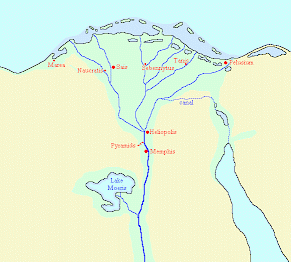Nepherites I
Nepherites (Egyptian Nef'aurud): first pharaoh of the twenty-ninth, Mendesian dynasty (398-392/391).

In the fifth century BCE, Egypt was part of the Achaemenid empire. However, in 404, a quarrel started between king Artaxerxes II Mnemon and his younger brother Cyrus, which lasted until 401. The Egyptians, led by Amyrtaeus, seized the opportunity and regained their independence. His reign, however, was unstable, and he was removed from the throne by Nepherites. This man was the first pharaoh of the Twenty-Ninth or Mendesian dynasty, named after the new capital of Nepherites, his birthplace Mendes, in the eastern Delta.
From Amyrtaeus, Nepherites inherited a war against the Persians and a coalition with the Greek town Sparta, which had invaded Asia in 400. To Egypt, this coalition was advantageous, because it kept the Persians occupied. To the best of our knowledge, there was no danger from their side during Nepherites' reign. In return, Egypt was obliged to send Sparta grain and the equipment for a hundred warships. Unfortunately, the fleet that was to bring this to the north approached the isle of Rhodes without knowing that it had sided with Persia, and was lost to the enemy.
In spite of this was a setback, Nepherites was a successful pharaoh, because he was able to pacify the country that had still been unquiet when his reign started. During his brief reign, Nepherites carried out several building projects, such as a turning station for the bark of Amun at Karnak (which was finished by his successors).
Nepherites died in 392/391 and was succeeded by Achoris, whose reign was briefly interrupted by that of Psammuthis. Both men were relatives of the dead king, although we do not know how; nor do we know why Psammuthis revolted. Achoris ultimately overcame his opponent.
Nepherites was burried at Mendes, the town he had chosen as his capital. The archeologists who discovered the sarcophagus (in 1992) noticed that the remains had been destroyed, probably when the Persians reconquered Egypt in 342.